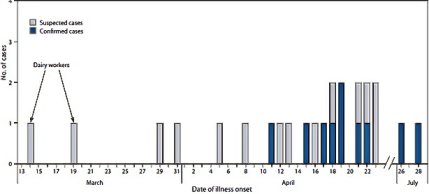The U.S. Centers for Disease control Morbidity and Mortality Weekly report was released this week. In it, a food poisoning outbreak at a minimum-security correctional facility was discussed. That facility, the Four Mile Correctional Center in Canon City, is a “designated work center where inmates are employed or receive vocational training.”
In 2010, the Colorado Department of Public Health and Environment (CDPHE) started investigating an outbreak of Shiga toxin-producing E. coli 0111 (STEC 0111). Ten inmates at the facility were confirmed victims of the bacteria.
Investigators found that 14 other inmates had the same symptoms, including bloody diarrhea. Pulsed-field gel electrophoresis (PFGE) testing found that the bacteria in stool samples matched bacteria taken from cattle at the facility’s on-site dairy.

That on-site dairy provides milk to all of the state-run prisons and jails in Colorado. But that isn’t the end of the story. CDPHE staff inspected the prison’s kitchens and found many violations of food safety handling laws, including:
Poor adherence to standard foodservice protocols and hygiene practices, including food handlers working while ill with diarrhea.
Inconsistent availability of hand soap throughout the facility.
Dairy employees wearing soiled work clothes into the kitchen and living areas.
Transport of potentially fecally contaminated lunch coolers and water containers from the dairy into the kitchen.
Some dairy workers washed their hands infrequently, consumed food and beverages in contaminated areas, and did not wear proper personal protective equipment.
In other words, people with diarrhea were preparing food, not washing their hands while preparing that food, and poop could find its way into the kitchen. And animal-to-human STEC 0111 transmission was occurring at the dairy.
The report recommends that officials at all correctional facilities should “consult with public health officials to design and implement effective infection control measures.”
The investigators listed the following “public health recommendations”:
- Prohibiting potentially contaminated material (e.g., lunch coolers, water containers, and work clothing from the dairy) in the kitchen area.
- Excluding from work all food handlers reporting diarrheal illness.
- Requiring food handlers with a confirmed STEC O111 test result to have two consecutive negative stool specimens before returning to work.
- Limiting transfers of inmates to other facilities until they were cleared by the medical staff.
- Providing training on transmission pathways, recognizing illness, and appropriate precautions when working with animals
- Modifying work flow patterns and designating contaminated, transition, and clean areas
- Implementing hygiene practices.
That facility has had no additional cases of STEC 0111 since July 2010.
There have been many other food poisoning outbreaks at prisons around the country.
- In July 2011, more than 300 inmates and staff at a Pennsylvania prison were sickened with Salmonella caused by contaminated chicken. Salmonella infections are especially threatening to prisoners who have human immunodeficiency virus infections.
- Also in November 2011, hundreds of inmates at the Northwest Florida Reception Center were sickened by a flu-like illness that may have been food poisoning.
- An outbreak of gastroenteritis in May 2011, most likely caused by Clostridium perfringens in chili macaroni, sickened 152 teenagers and staff at two juvenile correctional facilities in Kansas, one in Topeka and one in Larned. That same facility had another outbreak the month before which they did not report to authorities as required by law.
- An outbreak in 2010 in an privately run Idaho prison sickened two inmates. It was caused by a toxigenic strain of E. coli. The water at that facility was tested and found positive for coliform bacteria.
- In Golden Colorado in July 2007, there was a Shiga-toxin producing E. coli outbreak in a Jefferson County jail that sickened 12% of the jail’s 1200 inmates.
- According to the CDC’s Foodborne Outbreak Database, there were nine other foodborne illness outbreaks in U.S. prisons in 2009 (the latest year data was available); two caused by Clostridium perfringens, one caused by staphylococcus, and one caused by Salmonella enterica. The causes of the other outbreaks were not identified. A total of 881 inmates were sickened.
Prisons, like school cafeterias, nursing homes, and hospitals, are at high risk for foodborne illness, especially outbreaks due to bacteria such as Clostridium perfringens that grow when foods are cooked properly, but are then held at temperatures that may not be safe. That was the case in the outbreak at the Kansas juvenile facility.
Crowded conditions in prisons also contribute to outbreaks. In fact, according to SourceWatch.org, some of the largest foodborne illness outbreaks occur in correctional facilities.
Human-to-human spread of some bacterial infections is possible even when those infections begin in contaminated food. And norovirus outbreaks, which are often spread through foods handled by ill preparers or servers, are notorious in institutional settings such as prisons.
The conclusion reached by a study conducted by the Centers for Disease Control and Prevention states that “food production in correctional facilities should meet minimum safety standards, including sufficient refrigeration facilities, training of food handlers, and exemption of ill food handlers from work.”




